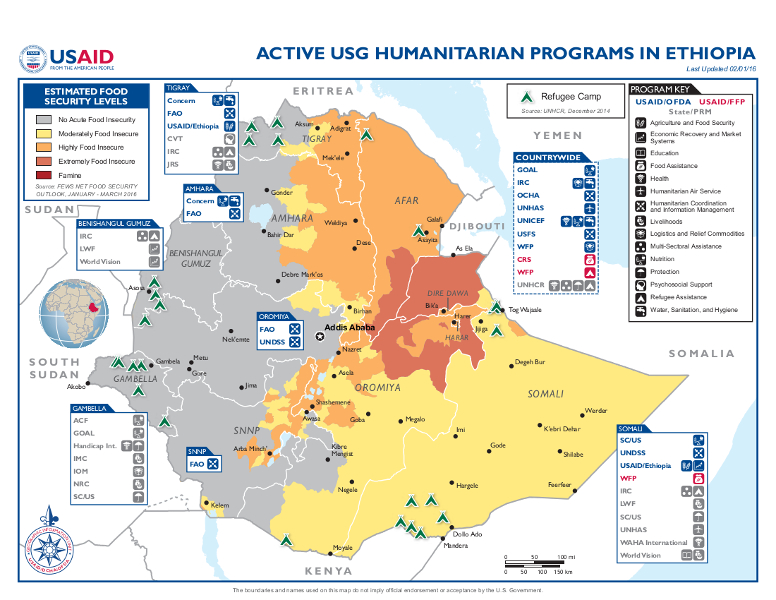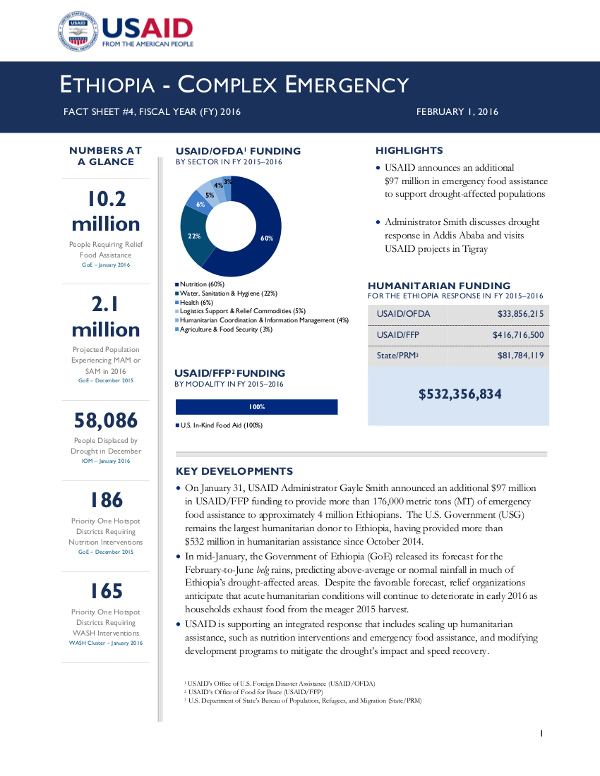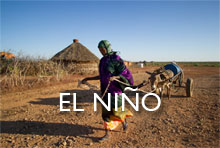- What We Do
- Agriculture and Food Security
- Democracy, Human Rights and Governance
- Economic Growth and Trade
- Education
- Ending Extreme Poverty
- Environment and Global Climate Change
- Gender Equality and Women's Empowerment
- Global Health
- Water and Sanitation
- Working in Crises and Conflict
- Disaster Assistance
- Political Transition Initiatives
- Conflict Mitigation and Prevention
- Countering Violent Extremism
- Disaster Risk Reduction
- Peacebuilding and Reconciliation
- Providing Safe & Secure Environments for Development
- Recovering From Crisis
- Resilience
- Tech Challenge for Atrocity Prevention
- World Humanitarian Day
- U.S. Global Development Lab
February 1, 2016
Highlights
USAID announces an additional $97 million in emergency food assistance to support drought-affected populations
Administrator Smith discusses drought response in Addis Ababa and visits USAID projects in Tigray
Key Developments
Ethiopia Map - 02-01-2016 ![]() (pdf - 750k)
(pdf - 750k)
Numbers At A Glance
10.2 million
2.1 million
58,086
186
165
Humanitarian Funding
For the Ethiopia Response
FY 2015 - 2016
| USAID/OFDA | $33,856,215 |
| USAID/FFP | $416,716,500 |
| State/PRM | $81,784,119 |
| TOTAL | $532,356,834 |
On January 31, USAID Administrator Gayle Smith announced an additional $97 million in USAID/FFP funding to provide more than 176,000 metric tons (MT) of emergency food assistance to approximately 4 million Ethiopians. The U.S. Government (USG) remains the largest humanitarian donor to Ethiopia, having provided more than $532 million in humanitarian assistance since October 2014.
In mid-January, the Government of Ethiopia (GoE) released its forecast for the February-to-June belg rains, predicting above-average or normal rainfall in much of Ethiopia’s drought-affected areas. Despite the favorable forecast, relief organizations anticipate that acute humanitarian conditions will continue to deteriorate in early 2016 as households exhaust food from the meager 2015 harvest.
USAID is supporting an integrated response that includes scaling up humanitarian assistance, such as nutrition interventions and emergency food assistance, and modifying development programs to mitigate the drought’s impact and speed recovery.
CURRENT EVENTS
From January 29 to February 1, USAID Administrator Smith attended the African Union Summit in Ethiopia’s capital city of Addis Ababa. On January 31, the Administrator was a panelist on a roundtable focusing on the drought in Ethiopia, along with the Executive Director of the UN World Food Program (WFP) Ertharin Cousin, UN High Commissioner for Refugees Filippo Grandi, and European Commission Vice President Kristalina Georgieva. UN Secretary General (SYG) Ban Ki-moon opened the roundtable, co-chaired by the UN Assistant Secretary-General and Deputy Emergency Relief Coordinator Kyung-wha Kang and GoE Deputy Prime Minister Demeke Mekonnen.
During the event, Administrator Smith noted that given the scope of the crisis and funding needs, the international community must seek out non-traditional donors—including the private sector—while traditional donors must also increase assistance. Further, Administrator Smith stated that the current response differs significantly from previous droughts in Ethiopia given strong GoE leadership, a unified strategy among response actors, and the investments in resilience and development programs during recent years, thus presenting a historic opportunity to address a drought crisis in Ethiopia. However, without increased support from international donors, the response also risks failing to meet the needs of millions of vulnerable Ethiopians in drought-affected locations.
On February 1, a U.S., UK, and UN delegation traveled to Tigray Region to assess the impact of the drought, meet with local officials, and view ongoing development and relief programs. The USG delegation comprising Administrator Smith, U.S. Department of State Bureau of African Affairs Assistant Secretary Linda Thomas-Greenfield, and USAID Africa Bureau Assistant Administrator Linda Etim visited Tigray with UK Ambassador to Ethiopia Susanna Moorehead, Deputy Head of the UN Office for the Coordination of Humanitarian Affairs (OCHA) in Ethiopia David Del Conte, and WFP Country Representative John Aylieff. The delegation met with the President of Tigray Region and visited a USAID/FFP Development Food Assistance Program site in Wukro District, East Tigray Zone, that supports activities such as agroforestry, bench terracing, fruit production, livestock watering points, a seed nursery, and water harvesting structures. The delegation also visited a livestock slaughterhouse that USAID has supported through the Feed the Future initiative to expand production and access to new markets. Finally, Administrator Smith and the delegation met with representatives from the non-governmental organization (NGO) GOAL to discuss ongoing joint USAID/OFDA- and USAID/FFP-supported rapid nutrition responses in drought-affected areas of Ethiopia, including Tigray.
The delegation’s trip to Tigray, encompassing longer-term development and emergency nutrition interventions, highlighted USAID’s efforts to layer development and humanitarian programming in a comprehensive approach to enhance longer-term food and nutrition security for populations in Tigray while scaling up humanitarian interventions during crises.
AGRICULTURE AND FOOD SECURITY
In mid-January, the GoE National Meteorological Agency released its forecast for the February-to-June belg rains, anticipating an early start to the belg, with normal cessation by June. The forecast predicts that southern and southeastern Ethiopia will likely receive above-average rainfall, while central, eastern, and northeastern areas of the country should receive normal rainfall with sporadic periods of above-normal rain. Meanwhile, western and northwestern parts of the country will likely receive normal or below-normal belg rainfall—with some areas likely experiencing dry periods given erratic belg rains in recent years. During 2015, Ethiopia experienced below-average or failed belg rains in many parts of the country, which contributed to the current drought and food security crisis.
As a result of poor or failed harvests in 2015, the UN Food and Agriculture Organization (FAO) estimates that approximately 838,000 households in Ethiopia require emergency seed assistance for the two main planting seasons in 2016—the January-to-April belg season and the June-to-August meher season. The recent FAO figure is an approximately 75 percent increase compared to the 477,000 households requiring seed assistance identified by the 2016 Humanitarian Requirements Document (HRD) in December 2015.
Due to the poor belg harvest in 2015, seeds are scarce for Ethiopian farmers preparing to plant during the upcoming season. The belg accounts for only 10 to 20 percent of national production but is a key cropping season in some areas
NUTRITION
Between January and November 2015, nutrition actors reported treating nearly 322,000 cases of severe acute malnutrition (SAM) among children younger than five years of age, according to the UN Children’s Fund (UNICEF). Monthly SAM caseloads moderately declined in October and November; however, UNICEF projects that the monthly SAM caseload will increase significantly starting in February 2016 as households deplete food stocks from the below-average 2015/2016 meher harvest.
In FY 2015 and to date in FY 2016, USAID/OFDA has provided nearly $19.5 million to support emergency nutrition interventions in Ethiopia for acutely malnourished children and pregnant and lactating mothers. USAID/OFDA programs support the treatment of SAM cases at stabilization centers—including provision of therapeutic foods and medicines—and through outpatient therapeutic feeding programs. USAID/OFDA is also treating cases of moderate acute malnutrition (MAM) through community-based management of acute malnutrition to prevent individuals from deteriorating to SAM levels of malnutrition.
OTHER HUMANITARIAN ASSISTANCE
On January 29, the Government of Japan pledged more than $21.7 million to support emergency response efforts related to the ongoing drought in Ethiopia, according to international media. In addition, SYG Ban announced on January 29 approximately $11 million in emergency assistance from the UN Central Emergency Response Fund (CERF)—a pooled humanitarian fund established and managed by the UN to support sudden-onset and underfunded emergencies—to support life-saving relief activities in Ethiopia.
On January 28, the governments of Ireland and Italy announced approximately $3.8 million and $1.1 million, respectively, in additional funding for the Ethiopia response. Government of Italy funding will support the WFP and FAO to provide emergency food assistance and seed interventions to agro-pastoral and other vulnerable communities in Ethiopia.
The additional Government of Ireland funding will support WFP relief operations in Ethiopia, including emergency food assistance and nutrition interventions. The Government of Ireland also plans to provide approximately $11.3 million to support the GoE-led Productive Safety Net Program (PSNP) during 2016. The 2016 PSNP is supporting 7.9 million food-insecure people with cash or food assistance between January and July.
CONTEXT
Multiple consecutive seasons of below-normal rainfall—exacerbated by the effects of the El Niño climatic event—have resulted in deteriorating agricultural, livestock, food security, and nutrition conditions in northeastern and central Ethiopia. By January 2016, the GoE estimated that 10.2 million people required emergency food assistance and other humanitarian interventions.
While drought remains a major contributor to vulnerability in Ethiopia, negatively affecting the lives and livelihoods of farmers and pastoralists, populations also continue to confront other challenges—including seasonal flooding, localized intercommunal conflict, above-average food prices, disease outbreaks, and limited access to health and WASH services—that contribute to sustained humanitarian needs and an ongoing complex emergency in Ethiopia.
On October 7, 2015, U.S. Chargé d’Affaires, a.i., Peter H. Vrooman redeclared a disaster for Ethiopia in response to the ongoing complex emergency.
PUBLIC DONATION INFORMATION
The most effective way people can assist relief efforts is by making cash contributions to humanitarian organizations that are conducting relief operations. A list of humanitarian organizations that are accepting cash donations for disaster responses around the world can be found at www.interaction.org.
USAID encourages cash donations because they allow aid professionals to procure the exact items needed (often in the affected region); reduce the burden on scarce resources (such as transportation routes, staff time, and warehouse space); can be transferred very quickly and without transportation costs; support the economy of the disaster-stricken region; and ensure culturally, dietary, and environmentally appropriate assistance.
More information can be found at:
- USAID Center for International Disaster Information: www.cidi.org or +1.202.821.1999.
- Information on relief activities of the humanitarian community can be found at www.reliefweb.int.










Comment
Make a general inquiry or suggest an improvement.